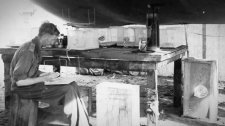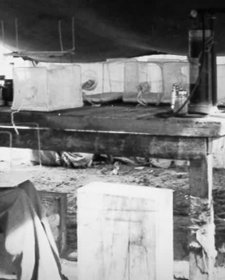Douglas Frew Waterhouse AO CMG (1916–2000), entomologist, identified the active ingredients for the insect repellent later marketed as Aerogard. As head of the Entomology division of CSIRO from 1960 to 1981, he championed the use of the dung beetle for biological control of bush flies. He was the driving force behind the Australian National Insect Collection, the Stored Grain Research Laboratory and the use of nematodes and synthetic sex pheromones for controlling insect pests. Over the course of his career he oversaw a number of valuable pest management projects in Papua New Guinea, Asia and the Pacific. He was a Fellow of the Royal Society and the Australian Academy of Science and the recipient of numerous awards and medals.
A lenticular print is formed of many ridges which act as lenses. The microscopically corrugated surface causes the image to 'move' as the as the angle of the viewer changes. Around and across Waterhouse artist Robyn Stacey placed emblems of his work, observing that the lenticular print is especially apposite for depicting insects, as 'the image literally appears to develop itself … the image itself becomes a metamorphosis.'
Commissioned with funds from the Basil Bressler Bequest 2003
© Robyn Stacey
Douglas Frew Waterhouse, by Robyn Stacey, 2003. This work is a lenticular photograph: its microscopically corrugated surface causes the image to appear to move or change with the angle of the observer. The work stands 123 cm tall and 93 cm wide.
The work is composed of a collage of photographs depicting the life and work of entomologist Douglas Frew Waterhouse. The photographs are developed in blue-toned greyscale framed within a wide white border and interrupted and obscured by a scattering of vibrant red butterflies.
The top half of the work shows a photograph of Waterhouse in a white lab coat, a white shirt, and a black tie, looking through a microscope. Almost in profile and orientated to the left, the tip of his nose and lips are obscured by the opaque protector around the ocular tubes. Resting on the microscope stage, his left hand holds a glass bulbous vial, and his right, a long thin utensil, just touching the surface of the clear bubbled liquid within the vial.
In the bottom right corner of the frame, a photograph of a younger Waterhouse in fishing attire fades seamlessly from the larger photograph. In his right hand he holds a fishing rod in a pencil grip, the rod extending over his right shoulder. In his left hand a trout hangs vertically from its head.
Waterhouse wears a broad-brimmed hat, and an open-necked shirt with rolled sleeves, with suspenders and the strap of a cross-body satchel visible over his shirt. His trousers are soaked wet up to the knees. Immediately to the right of the younger Waterhouse, an enlarged image of a black dung beetle has been imposed over the edge of the portrait, extending into the white border around the collage.
To the bottom left of the work, a printed rubbing of an open-mouthed trout has been positioned, seeming to glow with a bright indistinct white border around it.
These blue and white images stand in stark contrast to 27 butterflies of various sizes, each with black bodies and vibrant blood-red wings which have been superimposed over the collage. The butterflies are positioned largely along the left side of the work, with some extending across to its right side at the half-way point. They are positioned as if flying across the image, from the bottom-left to top-right, and their placement extends into the white frame around the collage.
Audio description written and voiced by Amy Middleby
Basil P. Bressler (44 portraits supported)



On one level The Companion talks about the most famous and frontline Australians, but on another it tells us about ourselves.



Australian entomologist and inventer of the Aerogard insect repellent, Douglas Frew Waterhouse describes the evolution of his career.



The considered matching of artist to subject has produced an amazing collection of unique and original works in the permanent collection of the National Portrait Gallery